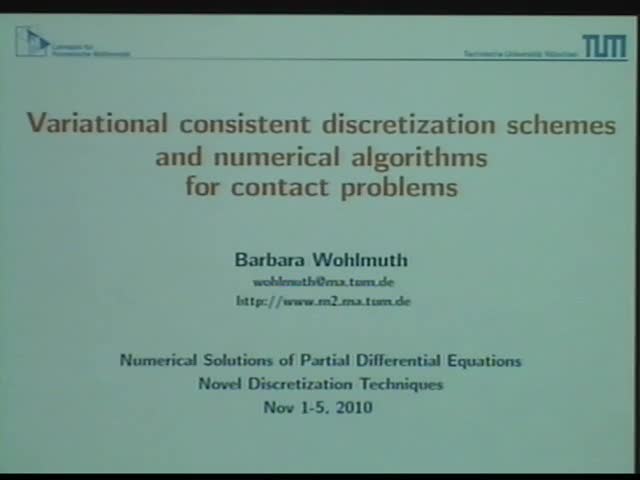Variational consistent discretization schemes and numerical algorithms for contact problems
Presenter
November 3, 2010
Keywords:
- Mechanical contact problems
MSC:
- 70Q05
Abstract
We consider variationally consistent discretization schemes for mechanical contact problems. Most of the results can also be applied to other variational inequalities such as those for phase transition problems in porous media, for plasticity or for option pricing applications from finance.
The starting point is to weakly incorporate the constraint into the setting and to reformulate the inequality in the displacement in terms of a saddle-point problem. Here, the Lagrange multiplier represents the surface forces, and the constraints are restricted to the boundary of the simulation domain.
Having a uniform inf-sup bound, one can then establish optimal low-order a priori convergence rates for the discretization error in the primal and dual variables. In addition to the abstract framework of the linear saddle-point theory, complementarity terms have to be taken into account. The resulting inequality system is solved by rewriting it equivalently by means of the non-linear complementarity function as a system of equations.
Although it is not differentiable in the classical sense, semi-smooth Newton methods, yielding super-linear convergence rates, can be applied and easily implemented in terms of a primal-dual active set strategy. Quite often the solution of contact problems has a low regularity, and the efficiency of the approach can be improved by using adaptive refinement techniques. Different standard types, such as residual and equilibrated based a posteriori error estimators, can be designed based on the interpretation of the dual variable as Neumann boundary condition. For the fully dynamic setting it is of interest to apply energy-preserving time integration schemes.
However, the differential algebraic character of the system can result in high oscillations if standard methods are applied. A possible remedy is to modify the fully discretized system by a local redistribution of the mass. Numerical results in two and three dimensions illustrate the wide range of possible applications and show the performance of the space discretization scheme, non-linear solver, adaptive refinement process and time integration.
